NEET Biology Phylum Chordata Diagnostic Characters
1. Dorsal hollow nerve cord.
- The chordates possess a centrally located neural system situated dorsally within the body. The structure consists of a longitudinal, hollow, or tubular nerve cord positioned superior to the notochord and running along the body’s length.
- The nerve cord, or neural tube, originates from the dorsal ectodermal neural plate of the embryo and encases a cavity known as the neuronal canal. No discernible ganglionic enlargements are present. The nerve cord facilitates the integration and coordination of the body’s functions.
- In vertebrates, the anterior segment of the nerve cord is adapted to develop a cerebral vesicle or brain, which is encased by a protective bony or cartilaginous skull. The posterior segment of the nerve cord develops into the spinal cord, which is safeguarded within the vertebral column
Read and Learn More NEET Biology Notes

2. Notochord or chorda dorsalis.
- The notochord is a flexible, elongated rod-like structure that spans the length of the body. It is located directly beneath the nerve cord and immediately above the stomach canal. It originates from the mesoderm. It originates from the endodermal roof of the embryonic archenteron.
- The structure consists of sizable vacuolated notochordal cells that contain a gelatinous matrix, encased by an outer fibrous sheath and an inner elastic sheath.
- The notochord is the principal distinguishing characteristic of the phylum Chordata, from which it receives its name. It functions as a support or internal framework and should not be conflated with the nerve cord.
- Protochordates possess a characteristic notochord. In adult vertebrates, it is encased or supplanted by the vertebral column.
3. Pharyngeal gill slits. In all the chordates, at some stage of their life history, a series of paired lateral gill clefts or gill slits perforate through the pharyngeal wall of the gut behind the mouth. These are variously termed as pharyngeal, branchial and visceral clefts or pouches.
Phylum Chordata NEET Notes
They serve primarily for the passage of water from the pharynx to the outside, thus bathing the gills for respiration. The water current secondarily aids in filter-feeding by retaining food particles in the pharynx.
In protochordate (For example Branchiostoma) and lower aquatic vertebrates, the gill slits are functional throughout life. But, in higher vertebrates, they disappear or become modified in the adult with the acquisition of pulmonary respiration.
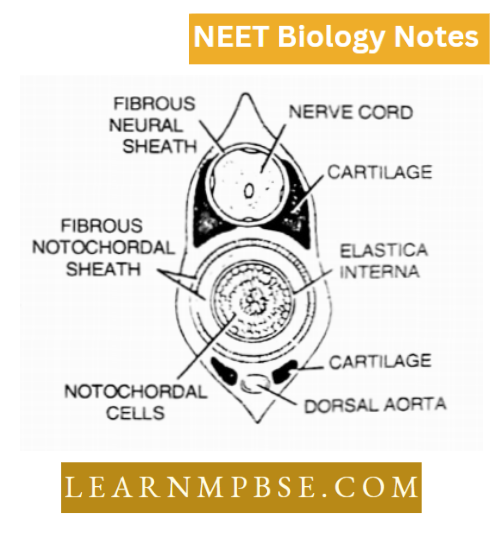
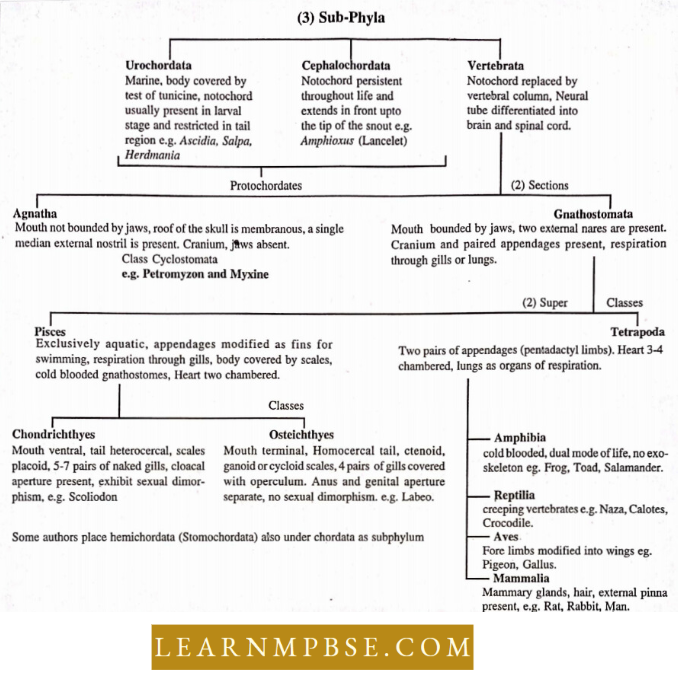
NEET Biology Phylum Chordata Sub-Phylum Urochordata
Important Features
- They are exclusively marine, solitary’ colonial, fixed, or free swimming.
- The body is enclosed in a loose investment called a tunic or test formed of tunicate.
- Epidermis single layered.
- Notochord is absent in adults but present in minute tadpole larvae.
- The dorsal, hollow nerve cord is present in the larval stage but gets reduced to a solid ganglion in adults.
- The body cavity is represented by an atrial cavity. Coelom is altogether absent.
- Pharynx perforated by numerous gill slits.
- The heart is ventral, simple, and tubular.
- Sexes united ie. hermaphrodite.
- There is usually retrogressive metamorphosis.
Characteristics Of Chordata NEET
Classification of Urochordata
3. Classes
- Class Larvacea (Appendicularia) eg. Appendicularia
- Class Ascidiacea Example Ciona, Molgula, Botryllus, Herdmania (Sea squirt)
- Class Thaliacca Example Dolioliwi, Salpa.

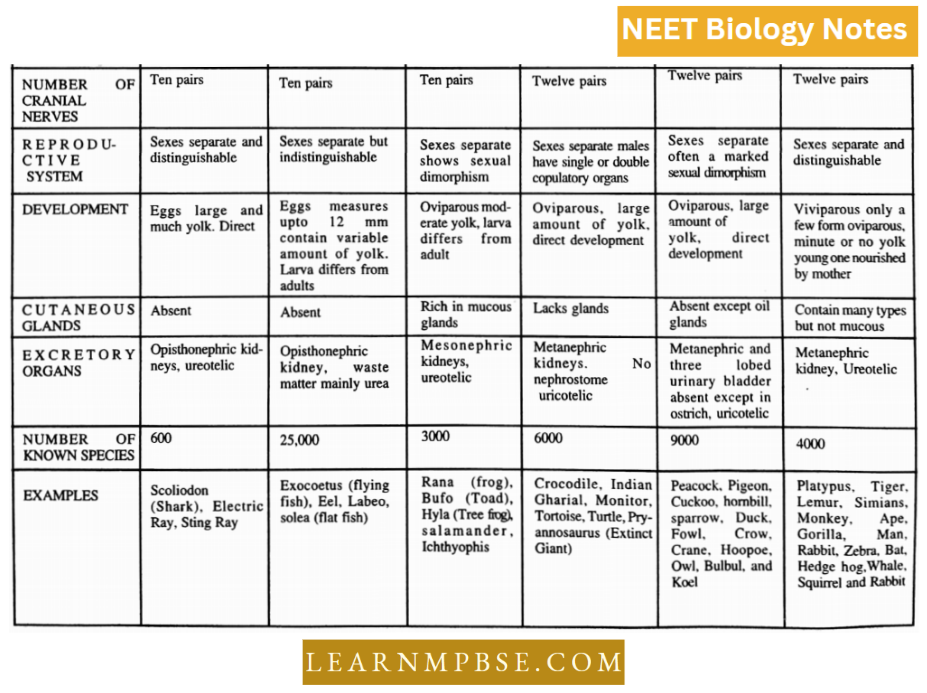
NEET Biology Phylum Chordata Sub Phylum Cephalochordata
Important features
- They are exclusively marine and solitary forms. The body is long and laterally compressed and is provided with median fins. Paired fins are absent.
- Notochord persistent and extends upload the tip of the snout hence cephalochordate.
- Along the median dorsal line, above the notochord is present a dorsal, hollow nerve cord or spinal tube, the anterior end of which is dilated into cerebral vesicles.
- The epidermis consists of a single layer of columnar epithelium.
- Definite coelom in addition to the atrial cavity is present.
- The pharyngeal gill slits are numerous that open into the atrial cavity.
- The body is metamerically segmented and the excretory organs arc protonephridia with solenocytes.
- The animals are dioecious or unisexual, but there is no sexual dimorphism.
- Gonads are metamerically arranged jn die bodies. Gonoducts are absent. Example: Amphioxus, Asymmetron
NEET Biology Phylum Chordata Sub Phylum Vertebrata
Distinguishing features
- The Notochord of the vertebrates is partly or fully replaced by a segmented vertebral column in adults.
- The neural tube is differentiated into the anterior brain and posterior spinal cord.
- Pharyngeal gill slits may be persistent or present at least during developmental stages.
Phylum Chordata Classification NEET
NEET Biology Phylum Chordata Section Agnatha
Distinguishing features
- Jaws are lacking in these vertebrates, hence, agnatha.
- The exoskeleton is usually absent.
- Paired appendages are absent.
- A single medial nostril is present in the case of these animals.
- The pharyngeal gill slits numbering 6-14 pairs are always present in the lateral wall of the pharynx.
- The notochord is persistent.
- They have numerous hook-like teeth in a round, funnel-shaped mouth.
- Section Agnatha has a single living class.
Class Cyclostomata
- The body of these animals is long and cylindrical.
- The skin is soft glandular without an exoskeleton.
- Paired fins are absent but the median fins are present.
- The mouth is circular, suctorial, and devoid of functional jaws.
- A single median nostril is present.
- The endoskeleton is cartilaginous.
- The notochord is persistent.
- The heart is two-chambered, and the aortic arches are many.
- External and middle ears are absent. The internal ear contains one or two semicircular
- A single gonad without gonoducts is present.
- Examples— Petromyzoii (Lamprey), and Myxine (Hagfish).
NEET Biology Phylum Chordata Class Chonprichthyes
Advancement of Cartilaginous Fishes Over Cyclostomcs
- Presence of exoskeleton of scales.
- Presence of paired fins and olfactory organ.
- Jaws are movable and bear teeth.
- Complete vertebrae present.
- Presence of visceral arches.
- Presence of three semicircular ducts in each car.
- Gonads arc paired provided with ducts and fertilization internal.
Classification 2-Sub Classes
- Sub Class: Sclachii (Elasmobranchii) Examples: Scoliodon (Dogfish,) Sphyma (Hammer-headed sharkj. Pristis (Saw fish), Rhinobatur (Guitar fish). Torpedo (Electric ray) and Trygon (Ming ray)
- Sub Class: Holocephali: Skin .scaleless in adult Example Chimaera (Rabbitfish)
- Class Osteichthyes (Bony Fishes)
- Advancement Over Cartilaginous Fishes
- Presence of homocercal tail
- Autostylic jaw suspension
- Better developed brain.
- Classification 2. Sub Classes
- Sub Class: Actinopterygii: Examples
- Aipenscr, Amia (Bow fin), Muraena (The Spotted Ed), Anguilla (The Ed). Rita rita (Catfish), Mystus (Catfish) Labeo rohita (Rohu), Catla catla (Carp), Hippocampus (Sea horse), Syngnathus (pipe fish).
- Exocoetus (Flying fish,) Anabas (Climbing perch), Diodon (Porcupine fish), Telradon (Globefish), Lopliius(The angler or fishing frog), Solea (Flatfish)
- 2. Sub Class: Sarcropterygii
- Examples Latimaria (The Coelacanth).
- Lcpidosiren (Lung fish). Protopterus (African mud fish-lung fish).
Phylum Chordata NEET Mcqs
NEET Biology Phylum Chordata Interesting Points Of Fishes
- The most powerful electric ray (Torpedo) produces an electric shock of 600 volts.
- Sound-producing fish: Tetragon
- Living fossil: Latimaria
- Ichthyology is the study of fishes.
- The climbing perch has gill chambers in its mouth to gulp in and store air, besides gills, where gas exchange takes place.
- The climbing perch can move short distances on land using its lateral fins.
- Fossil evidence shows that tetrapods arose from a group of fishes called the lobe-finned fishes. These fishes had functional lungs.
- The pectoral and pelvic fins of lobe-finned fishes had a fleshy lobe with a bony skeleton within. The tetrapod limb arose from such lobe-fins.
- A lobed-finned fish Latimaria is called a living fossil’. It is a deep sea fish occasionally found in the Indian Ocean.
- Anabas (climbing perch) occur in rivers of India and Southeast Asia. It has accessor}’ respiratory organs gill chambers for breathing atmospheric air which enable the fish to take long overland excursions in search of earthworms. Contrary to belief fish never climb up the trees.
- Catadromous fishes live in fresh water and go down to sea for breeding Example Anguilla (European eel). When fishes migrate from the rivers to the sea, it is called catadromous migration.
- Anadromous fishes live in seawater and migrate to the rivers for breeding Example Hilsa, Salmo (Salmon) migration is called anadromous migration.
- Gambusia fish was introduced into several tropical regions to control malaria.
- The copulatory organs of sharks are known as daspers.
- As cartilaginous fishes do not have a swim bladder as a hydrostatic organ so they have to swim continuously to neutralize the gravitational pull.
- Ampullae of Lorenzini are peculiar sense organs on their snout to note the thermal changes in water.
- The lateral line is with neuromast organs which have rheoreceptors and note changes in water currents.
- The electric organs of the Torpedo are modified muscles. These produce an electric current of 50-60 volts.
- Trygon (Sting ray or whip-tailed ray): The dorsal fin is modified into a spine for defense.
- Chimaera (Rabbitfish or ratfish or king of Herrings). Most advanced cartilage fish and acts as connecting link between cartilage fishes (Cartilages only, clampers) and bony fishes (4 pairs of gill slits covered by opercula, anus, and fleshy lips)
- Lung fishes use lungs for breathing. The lungs arise near the front end of the alimentary canal.
- Lung fishes
- Protopterns = African lungfish.
- Neoceratodus = Australian lungfish.
- Lepidosiren = South American lungfish.
- Latimeria (Coelacanth). A lobe-finned bony fish and is about 70 million years old. First reported by Miss Latimer called a living fossil.
- Fin rot of fise is caused by Psaulomoiuis.
Kinds Of Scales
They are of two types pidermal and dermal. Epidermal scales —The characteristics of reptiles, but are also found in a few mammals and on the bird’s feet.
They are formed of heavily keratinized stratum corneum. They overlap in lizards and snakes but fit side to side in turtles, tortoises, and crocodiles. The epidermal scales of chelonians.
Crocodiles and mammals, like pangolins and armadillos, are large and called Scutes. The scutes are not shed, but worn out and replaced. Pangolin, however, casts off its scutes singly and re-grows them.
The home on the snout of the male horned lizard Ceratophora and the fighting spurs on the leg of a fowl are modified scales.
Phylum Chordata NEET Exam Preparation
- Placoid Scales. A placoid scale has a disc-like basal plate.
- It resembles a tooth. These scales are found in cartilaginous fishes.
- Ganoid scales are heavy and have an outer layer of hard inorganic enamel-like material called ganoine. These scales are found in primitive bony fishes.
- Cycloid Scales. These scales have circular ridges. The cycloid (smooth) scales are found in higher bony fishes.
- Ctenoid Scales. These scales also have circular ridges but have more or less serrated free edges. Thus they are comb-like. Ctenoid scales are found in higher bony fishes.
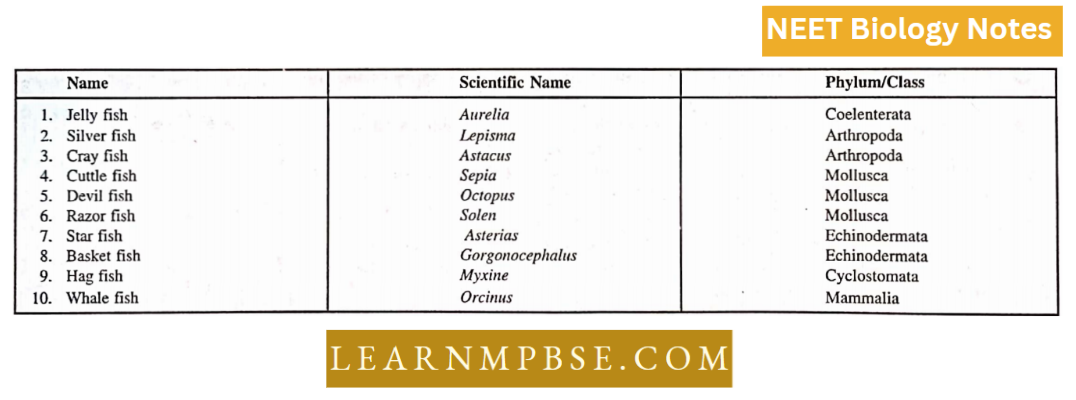
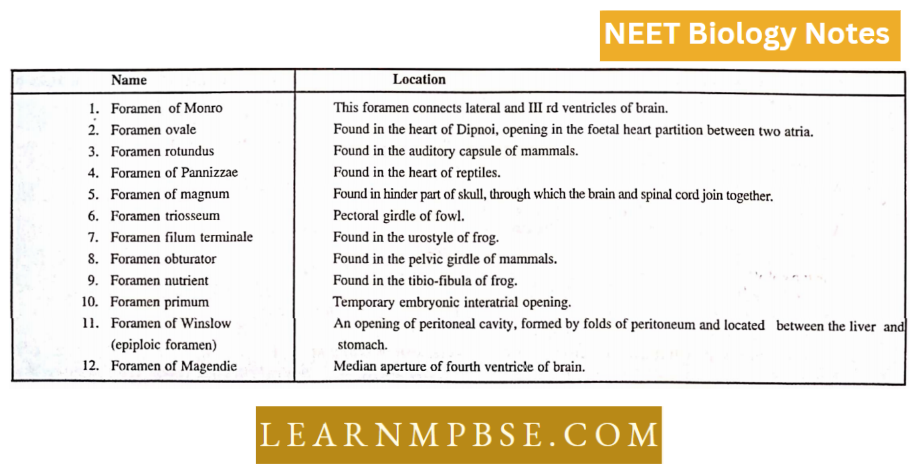
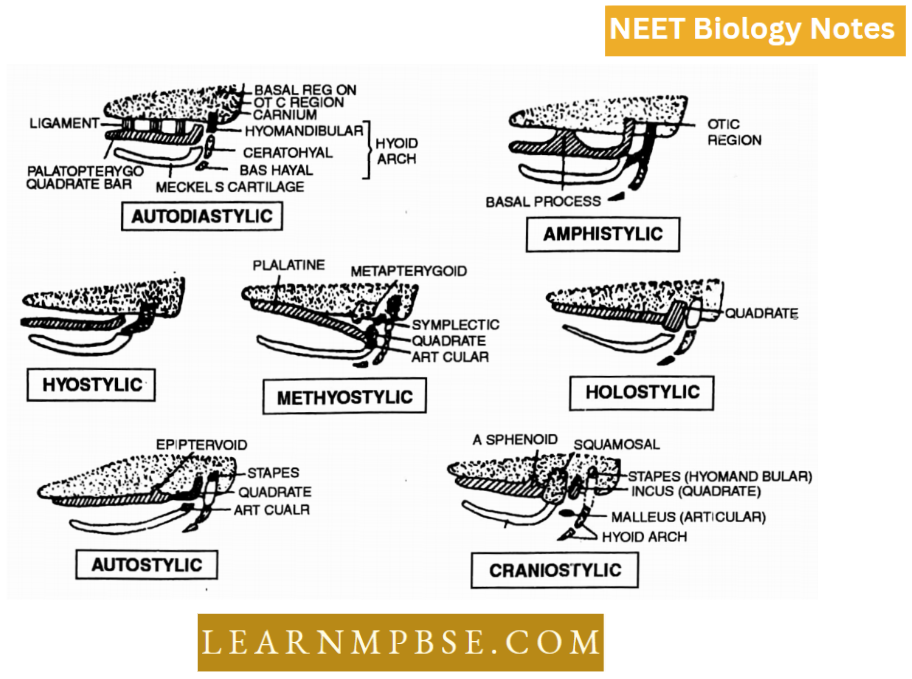
- Autodiastylic. found in the early bony fishes (most primitive) Example -Acanthodii.
- Amphistylic. found in primitive sharks, Hexanchus and Heptanchus.
- Hyostylic. evolved in more recent fishes and is found in elasmobranchs.
- Melhyostylic. is found in Amia, Lepisoteus, and teleostomes (bony fishes).
- Autostylic. found in most vertebrates, (show three variations.)
- Holostylic. developed in ancient placoderms and is still seen in Holocephali i.e. chimeras.
- Aufosytylic. found in Dipnoi (lungfishes) and tetrapods excluding mammals.
- Craniostylic. a characteristic of mammals.
NEET Biology Phylum Chordata Class Amphibia
Advancement of Amphibian overfishes
- Presence of limbs.
- Presence of articular processes on ver Protrusible tongue
- 3-chambered heart
- Presence of eyelids and urinary bladder.
Three main types of Amphibians
- Tailless order – Anura Frogs and Toad (2500 species)
- Tailed order urodele (Caudata) – Newts and salamander
- Limbless (orders Apoda = Gymnophiona = Caecilians)
Interesting Points About Amphibians
- Frog which lives in deserts – Trilling frog.
- Frog which carries tadpole in special pits on its back- Surinam toad (Pipa)
- Viviparous amphibian – Salamandra atra
- Earliest amphibian – Seymouria (Extinct)
- Amphibians originated in the Devonian Period.
- At the time of metamorphosis, the tadpole does not feed.
- Axolotls are larvae of a certain type of salamander. They are unusual in that my axolotls remain larvae all their lives but are still able to breed.
- Retention of larval characters by axolotl is called neoteny and reproduction by them is called paedogenesis.
- Blind worms (limbless amphibians) (Ichthyophis and Uraeotyphlus) are unusual amphibians as only one species that lives in water has scales.
- All the others burrow and are rarely seen on the surface. Many do not even need water to breed.
- The arrow poison frogs secrete a powerful poison from their skin which can cause instant death. These frogs are only found in Central and South America.
- Poisonous frogs often advertise the danger with bright yellow, orange, red, and black patterns. So that they can be easily avoided.
Phylum Chordata Examples NEET
- Most poisonous Frog. The golden dart poison frog from South America is the most poisonous. One adult frog contains enough poison.2200 people.
- Salamander is viviparous.
- Pipa, Xenopus, and Hymenochirus are tongueless amphibians.
- No amphibian is marine as may undergo exosmosis through its thin skin.
- Caecilians are limbless and tailless amphibians.
- Among amphibians, salamanders are ammonotelic in excretion.
- Though the amphibians are first terrestrial vertebrates but are still dependent on water for their reproduction, respiration, and larval development.
- Jaw suspension is autostylic.
- Vertebrae may be procoelous (2nd to 7th vertebrae in frog) amphicoelous (8th vertebra in frog) or acoelous (9th vertebra of frog).
- Caecilians have amphicoelous vertebrae while salamanders have opisthocoelous vertebrae (concave posteriorly and convex anteriorly).
- The tongue is anteriorly fixed and posteriorly free and protrusible in frogs and toads; non-protrusible in salamanders but is absent in Pipa (Surinam toad).
- Cutaneous respiration is the most important mode of respiration.
- Aortic arches are generally 3 pairs.
- The brain is covered by two meningeal membranes.
- The egg is generally isolecithal. Cleavage is holoblastic and unequal.
NEET Biology Phylum Chordata Class Reptilia
Advancement over amphibia
- Dry scaly skin, enables them to live away from water.
- Presence of movable independent neck.
- Presence of claws for defense.
- Limbs better suited (if present) for movements on land.
- Partial or complete division of ventricle leading to separation of oxygenated and deoxygenated blood.
- The presence of copulatory organs is essential for internal fertilization.
NEET Biology Phylum Chordata Interesting Points Of Reptiles
- Classification of Reptiles is based on temporal fossae.
- Linnaeus (1767) placed amphibia and reptilia together.
- Reptiles lived from the Triassic through the Jurassic and Cretaceous periods,
- Mesozoic Era—Also called the “Age of Reptiles.”
- Largest Living Reptiles
- Python,
- Crocodile
- Komodo dragon.
- Ophilogy or Serpentology. The study of snakes is termed morphology.
- Saurology. The study of lizards is termed saurology.
- Poisonous lizard — Heloderma
- Flying Lizard — Draco
- Desert lizard — Phrynosoma
- Largest living lizard — Varanus komodoesis (weight approx. 100 kg.)
- Heaviest reptile — Giant tortoise (600 kg)
- Colour-changing lizard — Chameleon
- Largest snake — Python reticulatus
- Smallest snake — Leptotyphidps bilineata (thread snake)
- Longest Poisonous snake — Naja Hannah;(King Cobra)
- Most Poisonous snake — Hydrophis (Sea snake)
- Double-headed snake— Eryx john (Dornuhi)
- Longest fangs— Bitis gibanica (viper) (1.97 inches long)
- Longest life span— Giant tortoise (200 yrs.)
- Herpetology— Study of reptiles
- Rattle snake’s tail emits a frightening sound that scares away the enemy.
- The king cobra of India is the only snake in the world that builds a nest.
- Dermal scales are best developed in chelonians (Tortoises and turtles and in the form of large bony plates).
- Some lizards and snakes also have dermal scales and epidermal scales.
- Abdominal ribs called gastralia generally four crocodilians and Sphenodon are dermal derivatives.
- The spikes on the head of Phiynosoma (Homed toad) are sharp, spiny, epidermal scales.
- Sphenodon is an ancient reptile found in New Zealand and despite its long evolution of 170 million years it has retained primitive characteristics, thus regarded as a “living fossil”.
- The primitive characters arc two unmodified temporal fossae, amphicoelous vertebrae, and abdominal ribs.
- The glass snakes are limbless lizards and are snake-like.
- In the crocodiles, the heart is four-chambered.
- A giant tortoise Geochelonegigantica lived for152 years i.c. 1766-1918 in Seychelles Islands of the Indian Ocean.
- No Indian lizard is poisonous.
- The Gila monster, Hclodcrma is the only poisonous lizard in the world. There are only two species.
- The Komodo dragon, Varanus kowodoensis of Indonesia measures 3 metres in length.
- The forked tongue of snakes simply gives a “stereo” sense of smell to them. Snakes have an organ called Jacobson’s organ within their mouth that helps them to detect odors.
- The fangs of a poisonous snake are maxillary teeth.
Phylum Chordata NEET Notes
- Reptiles without urinary bladder—snakes, crocodiles, alligators.
- Many sea snakes are viviparous. Pit vipers are also mostly viviparous.
- The oldest living animal in any Indian Zoo is the Aldabra giant tortoise. It has been living in the Alipore Zoo in Kolkata since 1875. It is 1.3 meters long.
- Long dinosaur—Diplodocus 27 m. Small dinosaur—Compsognathus—75-91 cm.
- Eryx johni (double-mouthed snake or sand boa): The tail is blunt and looks like a head.
- Snakes with neurotoxic venom: Bungarus (Krait); Naja (Cobra); Hydrus (Sea snake).
- Venom of Cobra is used to relieve intense pain in cases of cancer.
- Fat bodies of uromastix yield oil which cures potency.
- Snake with hemolytic venom. Vipera (Pit viper).
- Dinosaurs (meaning terrible reptiles) were giant-sized fossilized reptiles from about 200 million years ago in the Mesozoic era (called the age of reptiles) Example Brontosaurus (Thunder lizard An herbivorous dinosaur and tyrannosaurus tyrant Lizard A carnivorous dinosaur).
List of poisonous snakes of India
- Cobra (Naja naja)
- King Cobra (Naja lianna)
- Common krait
- Branded krait
- Black krait
- Russel’s viper
- Saw scaled viper
- Himalayan pit viper
- Hump nosed viper
- Indian Sea snake
- Bengal Sea snake
- Indian coral snake
- Smallest reptile – Grecho
- Largest reptile – Crocodylus porosus
- Shortest snake – Thread snake
- Largest snake – Python (10 Metres)
- Poisonous lizard – Heloderma
NEET Biology Phylum Chordata Class Ave
Advancement of Birds over Reptiles
- The presence of an insulating cover over the body and body is homcothcrinnl.
- Complete sepnralhni of oxygenated and deoxygenated blood in the heart.
- Plight a means of very rapid locomotion.
- Lungs are very well aerated.
- Presence of syrinx and producing organs.
- More efficient eyes with double power of accommodation.
- Modern birds lack teeth.
Adaptation Of Birds For Flight
- The fore-limbs are modified into wings to provide a large surface area formed by the structures called feathers which are light in weight.
- The sternum is extended to form a keel. Large (light muscles are attached to the keel.
- Powerful flight muscles named pectoral ninjas are present.
- The body is streamlined.
- Weight is kept to a minimum by the possession of a very light skeleton with hollow bones and an air sac
- The efficient flight is achieved by the birds taking advantage of vertical air movements i.e., by gliding and soaring.
- The coracoid bones arc is well developed to transmit the “Lift” of the wings to the whole body.
- The brain is well developed.
- The metabolic rate of birds is relatively high to provide the energy required for flight.
Phylum Chordata Examples NEET
NEET Biology Phylum Chordata Interesting Points Of Birds
- The urinary bladder is absent in birds except for ostrich.
- True penis (copulatory organ present in swans- ducks – geese and ostriches.
- A bird that undertakes the longest migration is the Arctic tern, Sterna macrura covers about 40,000 km. each year.
- The only bird that hibernates in winter. (Caprimulgus)
- Strulhio camelus is the largest living bird
- Archaeopteryx is regarded as an ideal connecting link between birds and reptiles.
- Both fossil birds, Hesperornis regalis and Ichthyornis victor had true teeth.
- Hummingbirds beat its wings 60 times per second.
- Guano—excreta of sea birds.
- ‘Wagtail’ migrates from Siberia to India during winter not for breeding, but for feeding.
- Lagena is a part of the membranous labyrinth of the bird associated with hearing.
- Uropygiinn (tail): the projecting terminal portion of a bird’s body from which the tail feathers arise.
- Among the Indian birds, the sunbirds are probably the smallest.
- The dove is the emblem of the sign of peace.
- The hummingbird is the only bird that can fly backward as well as forward.
- The Bursa fabricus is a blind sac with much lymphoid tissue in the cloaca of some young birds. It produces lymphocytes (a type of white blood corpuscles).
- It is also called ” cloacal thymus.”
- Columba has the world’s richest diversity of birds.
- The bird Dodo became extinct because of its fearlessness.
- African Fish Eagle is called the Voice of Africa because of its familiar yelping call.
- An owl moves its head from side to side to judge distances accurately.
- Its eyes do not rotate in their sockets. Each eye is fixed like a car headlight.
- Ostriches are beneficial to Zebras because ostriches act as lookouts for Zebra herds, warning them of approaching danger Copulatory organ (true penis) is present in ostrich, duck, swan,s, and geese.
- Famous Indian Ornithologist—Dr. Salim Ali.
- Birds which live on fish, need more food.
Vertebrates And Invertebrates NEET
- Swifts use saliva for binding nest materials.
- Hummingbirds build the smallest nests.
- Bald Eagle has the largest nest.
- Khtf lays the largest egg in proportion to its size.
- The Gentoo Penguin is the fastest-summing bird.
- Vervain Hummingbird lays the smallest egg.
- The Himalayan Bearded Vulture is the largest Indian bird. Previously the Sarus was considered the largest Indian bird
NEET Biology Phylum Chordata Class-Mammalia
Unique features and advancement over reptiles
- The body is covered with hair and highly glandular skin that is helpful in different ways.
- Presence of mammary glands.
- 7 (Seven) cervical vertebrae. The first two cervical vertebrae (Atlas and Axis) are specialized for the movement of the head.
- Denucleated R.B.C.
- Presence of diaphragm which divides the body cavity into thoracic cavity and abdominal cavity.
- Presence of pinna (external ear).
- The large cerebrum and cerebellum provide for better coordination in all activities of life for learning and retentive memory.
- Intrauterine development ensures the safety of the fetus. Viviparous.
- A better efficient mechanism for homeostasis

List of Orders of subclass Eutheria
- Insectivora. Presence of elongated snout, fossorial, nocturnal.
- Examples: Crocidura (Musk shrew, Henu’echinus (Hedgehog)
- H. Primata: Large rounded cranium, plantigrade, omnivorous, and gregarious. Pres ence of opposable thumb. They evolved from tree shrews.
- Examples: Prosimians (before the monkeys) Loris, Lemurs, and Tarsiers
- Simians, Macaca (Monkey) Apes (Gibbon, Orangutan, Chimpanzee, and Gorilla, Homo sapiens (Man).
- Chiroptera organs of flight are lateral extensions of skin termed patagia.
- Examples. A small bat, Pteropus (large bat or flying fox, Vampire)
- Polidota. The upper surface of the body is covered with home scales.
- Examples. Manis (Scaly ant-eater or Pangolin)
- Rodentia. Presence of one pair of sharp, chisel-like ever-growing incisors.
- Examples. Rattus (Rat), Mus (Mouse), Cavia (Guinea pig) and Funambulus.
(Squirrel). - Lagomorpha. Two pairs of incisors in the upper jaw.
- Examples. Rabbit and Hare.
- Cetacea. Fish-like body with smooth hairless skin. Examples. Whale, Dolphin, Porpoise.
- Carnivora Presence of sharp, well-developed claws, large canines, and strong jaws.
- Examples: Panthera leo (Lion), Panthera tigris (Tiger), Phoca (Seal).
- Proboscida. Presence of proboscis.
- Example: Blcphns (Elephant)
- Perissodactyl. Long limbs with a single functional digit (3rd) per foot. Presence of cornified hoofs. (Odd hoofed mammals) Examples: Rhinoceros, Equus (horse), Ass, Zebra.
- Artiodnclyln. Long limbs with two functional digits (2nd & 3rd) per foot. (Eyÿp hoofed mammals)
- Examples: Goat, cow, buffalo, pig, hippopotamus, camel, deer, and giraffe.
Vertebrates And Invertebrates NEET
NEET Biology Phylum Chordata Interesting Features Of Mammals
- The mammals, Ornithorhynchus (duck-billed platypus), Tachyglosstts, and Zagorssus (spiny ant eaters or echidnas) lay eggs, but young are nourished by milk from mammary glands.
- The hair of a mammal is a different structure from the scale of reptiles and the feathers of birds.
- The scales on some parts of the body of some mammals are modified
hair scaly ant cater or pangolins have scales on their backs whereas rats have
scales on their tail. - Nails, claws, hoofs, and horns of ruminants and the nasal horn of rhinoceros are
all derived from the same keratinized epidermal material as hair. - Male camel can drink 11) 4 liters of water at one time.
- Mammals originated from cotylosaurian reptiles in the Jurassic about 150 million
years ago. - The tertiary period, the Eocene epoch’ is called as age of mammals.
- Living species of mammals are about 4,400.
- Largest mammal
- Balaenoptera musculus (Blue Whale—Size 35 metres; weight 207 tons).
- Smallest mammal
- Suncus ctruscus (Pigmy shrew — weight 40 gms).
- Three groups of mammals:
- Prototherians: egg-laying mammals.
- Mctatherians: Pouched mammals.
- Eutherians: True placental mammals.
- The slowest moving mammal-3 toed sloth.
- Large brain, unique memory, speech, language, and opposable thumb arc some
features that make man separate from other animals. - The Holocene epoch is the ‘Age of Man’
- The trunk of an elephant is an elongated nose
- Tusks of elephants are modified incisors
- The most acute sense of smell is among mammals.
- The elephant has 40,000 muscles in its trunk. Not a single bone is found in it.
- Hylobates hoolock is the only ape found in India.
- The Indian one-homed Rhinoceros is the second largest land animal of India.
- Of all existing mammals, the human being is the longest-lived.
- Highest National I.Q. — 106.6. in Japan.
- Highest I.Q. in man—210 in a Korean boy of 14 years.
- 50% of the world’s buffaloes are in India.
- salivary glands are absent in whales and sea cows.
- All mammals have movable lips except whales.
- Echo location is useful in flight in bats.
- Vampires: Blood-sucking bats (Sanguivorous).
- Whales are hunted for their oil.
Phylum Chordata NEET Question Bank
- A hairless mammal in which milk is squirted down the throat of the body the muscu¬ lar contraction of the mother is a whale.
- Aquatic mammals such as whales, sirenians, and seals lack pinna. Platypus also does not have pinna,
- Gorillas do not drink water, water present in vegetation is sufficient for their needs.
- Tigers prefer to live near water
- The snow leopard is found in Lulakh.
- Wolf Is lastly disappearing from India.
- Man-eating tigers are most commonly found in Sunderbans, West Bengal.
- Asiatic Cheetah was once abundant in India but is now extinct.
- Platypus has teeth in its young stage which are replaced by fleshy membranes in adults.
- Mammals are most sensitive to nuclear radiation.
- The lion was the national animal of India till 1972. The tiger was declared the national animal of India in 1973.
- Pour evolutionary lines of Buthcrians:
- Insectivorous lines include insectivores, bats, and primates.
- Rodents and Lagomorphs include gnawing placentals.
- Whales, Dolphins, and Porpoises include aquatic placentals.
- Elephants, Carnivores, and Ungulates.
- The endothermic nature of birds and mammals enables these vertebrates to live in
areas with extreme temperatures. - The crocodilian line of reptiles resembles mammals in many characteristics like secondary palate, solid and spongy lungs, thecodont and heterodont teeth, diaphragm, 4-chambered heart, penis, etc.
- Echidna or Tachyglossus (Spiny anteater). Another prototherian of Australia, New Guinea, etc. It is insectivorous and ant caters (so is toothless).
- Hair on the back is modified into spines for defense. Gynaecomastia. Enlarged and functional mammary glands in male Echidna. In Kangaroo, the mother forces the milk into the buccal cavity of the mammary fetus and does not suck.
- Didelphis virginiana (North American opossum). An arboreal metatherian of
America and has a prehensile tail. It feigns death when disturbed.
NEET Biology Phylum Chordata Claws
They are present in reptiles, avians, and mammals. A claw encases the distal segment of a digit, which is internally supported by a terminal phalanx.
It comprises two keratinous plates:
- The top big unguis and
- The subungual.
The epidermis at the base of the claw is invaginated to create the claw root, which supplies new keratin layers for claw growth.
Certain carnivorous species possess retractable claws that are retracted into sheaths when not utilized.
NEET Biology Phylum Chordata Nails
- They occur in primates among mammals. The unguis is broad whereas the subunguis is greatly reduced. The dermis underlying the unguis is very vascular and called the nailbed.
- It imparts a pinkish color to the nail. The nail root (invagination in the epidermis) provides keratin for the growth of the nail. Lemurs have claws on some digits and nails on others.
NEET Biology Phylum Chordata Hoofs
- In this case, the unguis is very large and encloses the subungues within it. The animals walk on the unguis as the digit does not touch the ground. The unguis is very hard and wears off very slowly.
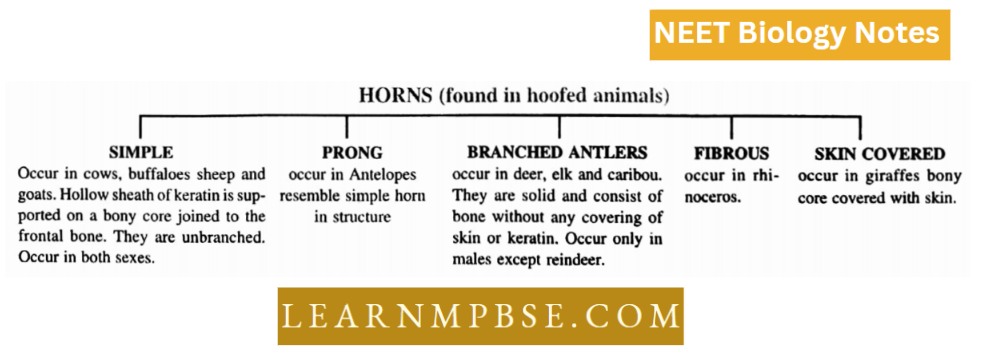
Urochordata
- Lamarck. Gave the term Tunicata.
- Herdmania is called sea squirt as it ejects two jets of water when disturbed.
- Ascidians are sedentary urochordates, while Doliolum and Salpa are pelagic urochordates.
- Pyrosoma. A colonial and sedentary urochordate.
- Oikoplcura. An appendicularian tunicate. The adult is with a tail and is covered by a gelatinous house and not a test.
- The tail is with a notochord. It shows neoteny or paedogenesis.
- Atrium. An ectodermal lined cavity to support the pharynx with numerous gill slits.
- The endostyle of urochordates is the forerunner of the thyroid gland.
- The circulatory system is open or lacunar type and the heart is neurogenic and not myogenic. The heart shows a periodic reversal of blood flow. Blood has vanadocytcs which extract vanadium from seawater.
- The excretory organ is a neural gland that lies below the brain and is homologous to the pituitary gland of vertebrates.
- Important members of ascidians:
- Herdmania. Sea potato or sea squirt.
- Ascidia. British sea squirt.
- Doliolum. A urochordate with a barrel-shaped body, opposite lying branchial and atrial apertures, and 8 complete muscle bands.
- Salpa. A urochordate with a prismatic body and ventrally incomplete muscle bands.
- Sexual zooid is called gonozooid or blastozooid, and white asexual zooid is called oozooi Ccphalochordata These are considered as blue print ofphylum Chordata orlt as have all the primary chordates characters even in the adult stage.
- Amphioxus. Also called Branchiostoma.
- Only median fins are present and are supported by fine ray boxes of connective tissue.
- Myotonies. Blocks of striated muscles.
- The buccal cavity has a wheel organ (also called Muller’s organ or rotatory organ).
- Excretion is by protonephridia having groups of flame cells called solenocytes.
- Cyclostomata
- These are commonly called round-mouthed eels.
- Only median fins are present and are supported by cartilaginous fin rays.
- The tail is protocercal (as the notochord extends straight upto the tip of the tail and two lobes of the caudal fin are equal).
- The intestine has a well-developed typhlosole.
- Marsipobranchial gills: When internal gills are located in pouches.
- RBCs are nucleated and circular.
- Cranial nerves are 8 or 10 pairs.
- Monorhinous: Single median nostril.
- Ammocoetes larva has endostyle like the protocol-or dates, while the adult has thyroid and pituitary gland
- Myxine (Hagfish or slime eel). The buccal funnel is absent but the mouth is surrounded by 4 pairs of oral tentacles.
- The nasal sac is connected to the pharynx. But has no ammocoetes larva. It is called borer as bores into the body of fishes and eats upon their soft tissues. The trunk has only one pair of gill openings but many openings of mucous glands.
